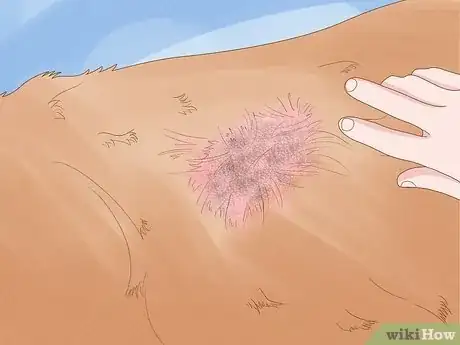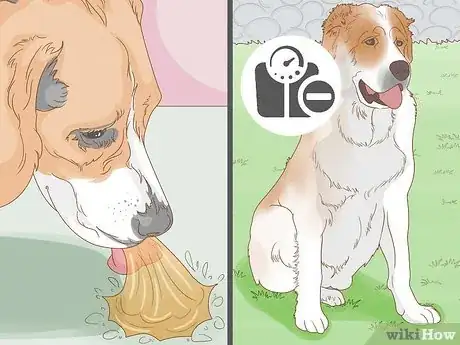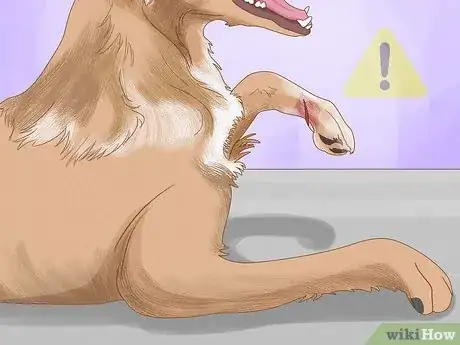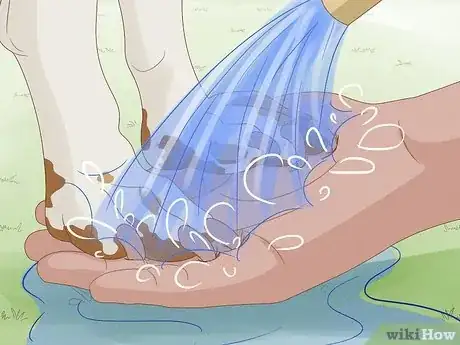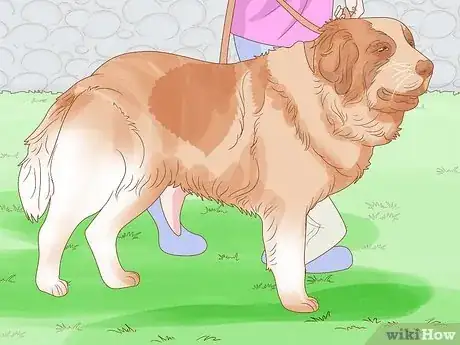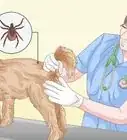This article was co-authored by Cameron Thompsen and by wikiHow staff writer, Eric McClure. Cameron Thompsen is a Dog Trainer and Human Coach, as well as the Owner and Founder of Hope2K9 Foundation. With nearly two decades of experience, she specializes in working with dogs and their owners on behavior issues ranging from severe anxiety, reactivity, as well as aggression and fear-based problems. She works with all dogs at Hope2K9 so that they are fully trained before adoption, and provides lifelong support to dog owners after adoption.
There are 17 references cited in this article, which can be found at the bottom of the page.
This article has been viewed 1,495 times.
If your dog’s paws turn red, you’ll probably notice your pup licking their paws frequently, limping, or biting at their nails. This is a condition known as pododermatitis, and it’s an extremely common symptom in dogs. While you usually need a vet to check this out first, the good news is that your treatment is likely going to be very straightforward and easy. Read on to learn what causes red paws, how you can treat them, and what you can do to prevent this in the future.
Things You Should Know
- Your dog’s paws are red because they’re swollen. This is known as pododermatitis, and it’s a symptom of irritation or an underlying medical condition.
- Pododermatitis is usually caused by overactivity, an allergy, or an infection, all of which are relatively easy to treat with medication, rest, or simple treatments.
- Potential serious causes of pododermatitis include autoimmune disorders, endocrine disorders, or cancer, all of which require medical intervention.
- Unless it’s a minor cut or overactivity, you must see a veterinarian to get a diagnosis for pododermatitis.
Steps
Causes
-
1Overactivity If you’ve noticed your dog’s paws are red after they’ve been running around for an hour, it can lead to pododermatitis—especially if it’s hot or cold outside. Friction, extreme temperatures, and excessive use can irritate their paws and lead to inflammation.[1] X Research source
-
2Allergies This is probably the most common cause of chronic pododermatitis. Just like people, dogs can be allergic to food ingredients, dander, pollen, fleas, or other environmental factors. If you’ve just adopted or bought a puppy, the red paws are likely an inherited allergy.[2] X Research source Other signs this is caused by an allergy include:[3] X Trustworthy Source American Kennel Club The American Kennel Club (AKC) is a purebred dog pedigree registry in the United States. The AKC advocates for the responsible ownership of dogs and promotes purebred dog events, such as the Westminster Dog Show. Go to source
- Swelling elsewhere on your dog’s body.
- Frequent itching, sneezing, or licking.
- An irregular frequency of vomiting, diarrhea, or ear infections.
- Runny eyes or hives.
Advertisement -
3Foreign object stuck in paw If the pododermatitis appears to be impacting only one of your dog’s paws and they’re limping, licking at the paw, or struggling to move normally, they may have stepped on some glass, thorn, or some other sharp object.[4] X Research source
-
4Bacterial or fungal infection Check your dog’s paws for any kind of discharge, puss, or flakey skin, all of which point towards an infection of some sing. The other big sign is the odor. Your dog is probably not going to smell very good, regardless of how often you bathe or clean your dog. Your pup is also likely to lick their paws obsessively if it’s an infection.[5] X Research source
- If you notice that your dog gets infections more than once every year or so, it’s likely that they’re allergic to something. Dogs with allergies are more prone to infections.
- This might sound scary, but it’s sort of like a person getting a yeast infection or athlete’s foot. It does require treatment, but it’s not the end of the world.
-
5Autoimmune disorders An autoimmune disorder occurs when your dog’s body can’t accurately differentiate between viruses/bacteria and normal cells.[6] X Trustworthy Source PubMed Central Journal archive from the U.S. National Institutes of Health Go to source The most common symptom to look for here are fur loss and skin lesions. If your dog has a lot of other skin issues, it’s likely autoimmune.[7] X Research source
- The vast majority of canine autoimmune disorders are diagnosed as pemphigus. This is a very treatable condition, so don’t worry just yet.[8] X Research source
-
6Hormonal or metabolic disorders The endocrine system controls hormones, metabolism, and chemicals in the brain, and these kinds of disorders often include pododermatitis as a symptom. Only as vet will be able to diagnose one of these issues, and the onset of symptoms can take various forms depending on the underlying cause.[9] X Research source
- Some of these issues are no big deal, while others require serious medical intervention. A vet will be able to tell you more.
-
7Cancer/neoplastic Nail bed squamous cell carcinoma and epitheliotrophic lymphoma are two types of cancer where pododermatitis is an early symptom. These conditions are quite serious, but rest assured that they’re quite rare—especially if your dog isn’t old. Take your dog to a vet to get a diagnosis and learn more.[10] X Trustworthy Source PubMed Central Journal archive from the U.S. National Institutes of Health Go to source
- Other symptoms of cancer include: weight loss, vomiting, diarrhea, mobility issues, trouble going to the bathroom, or sores.[11] X Trustworthy Source American Kennel Club The American Kennel Club (AKC) is a purebred dog pedigree registry in the United States. The AKC advocates for the responsible ownership of dogs and promotes purebred dog events, such as the Westminster Dog Show. Go to source
- Inspect your dogs paws for a tumor. If you feel any bumps or growths, point them out to your vet.
Treatments
-
1Overactivity: let your dog relax and heal on their own So long as your dog isn’t bleeding, this is no huge deal. Wash your pup’s paws with cool, clean water and just take it easy. Keep your dog inside, let them lie down, and just give them a day or two to heal naturally.[12] X Research source
- If your dog burned their paw pads, rinse the paw and then apply an antibiotic cream and bandage.
- If your dog is bleeding, rinse out the affected paw and apply pressure with a clean towel. So long as the bleeding stops, you can just bandage the paw with a gauze pad and vetwrap tape.[13] X Research source
-
2Allergies: see a vet to explore dietary changes or medication Your dog will likely need antibiotics to treat the allergic reaction if it’s bad enough that you notice it, so see a vet. From there, work on a treatment plan with the vet.[14] X Trustworthy Source PubMed Central Journal archive from the U.S. National Institutes of Health Go to source
- It can be kind of difficult (and expensive) to test for allergies. Most of the time, it’s easier to try and use the process of elimination to figure out what irritates your dog.
- You might start by switching your dog’s diet. If they’re eating chicken & rice kibble, try switching to lamb & potatoes, for example.
- Note when and where your dog has the most symptoms. They may be allergic to certain plants, so you can change your walk route, or allergic to seasonal allergens, which require shorter walks during the relevant season.
- If worst comes to worst, you can always give your dog a daily dose of Zyrtec per your vet’s guidance.
-
3Foreign object: remove and treat minor wounds or see a vet If you can’t find an object or the bleeding won’t stop, go to a vet now. Otherwise, gently remove the object with tweezers. Wash the paw with warm, soapy water and rinse the excess soap out. Bandage the paw if necessary and let your dog relax and heal.[15] X Research source
- So long as your dog continues to get better over time, this is no biggie. However, if your dog’s limping continues, it won’t stop bleeding, or they get worse, take them to the vet.
- While their paw heals, try to distract your dog to keep them from chewing their paws.
-
4Bacterial or fungal infection: see a vet to get antibiotics or other meds See your veterinarian to get a formal diagnosis. Most of the time, this is no big deal and you’ll be able to give your dog antibiotics to fight the infection. If that doesn’t work, your vet will likely prescribe probiotics to fight the condition.[16] X Research source
- Frequent infections are typically a sign your dog has an allergy, so explain how often this has come up with your vet.
-
5All other causes: see your vet and get a formal diagnosis Autoimmune disorders, endocrine issues, and cancer are not something you can treat on your own. In fact, a vet won’t be able to treat them either without a diagnosis. If you suspect this might be an underlying cause, do not hesitate to schedule an appointment.[17] X Trustworthy Source PubMed Central Journal archive from the U.S. National Institutes of Health Go to source
- Autoimmune disorders are often treated with steroids or other medication.
- The treatment for hormonal and metabolic disorders depends on the underlying condition. It could be as simple as some regular medication, or as serious as surgical intervention.
- Cancer and neoplastic syndromes are typically treated with surgery, medication, chemotherapy, or other interventions.
Signs of an Emergency
-
1Your dog collapses, struggles to breathe, or becomes inactive. If your dog has an acute allergic reaction and it happens to be serious, it’s an emergency situation that requires immediate medical care. Their face may swell up, have difficulty breathing, or experience a seizure if the reaction is bad enough. Find an emergency vet near you and take your dog there ASAP.[18] X Research source
-
2Your dog’s paw is bleeding and it won’t stop. Excessive blood loss can lead to serious medical complications, and even death. Look for a veterinary emergency room near you and take your dog there. Keep pressure on the wound with a clean cloth or bandage in the meantime.[19] X Research source
-
3You find nodules, growths, or tumors. This isn’t a “drop everything right now and go to the ER” emergency, but it does require veterinary care at your absolute earliest convenience. If this growth happens to be cancerous (and it may not be), it needs to be biopsied and checked so that treatment can begin.[20] X Research source
Preventative Tips for Paw Health
-
1Trim your dog’s nails regularly when they grow too long. If your dog’s nails grow too long, they can put unnecessary pressure on the dog’s nerves and paw. This can increase your dog’s odds of getting an infection or breaking their skin. Cut just above the quick at a 45-degree angle to remove excess growth and file the nail when you’re done.[21] X Research source
- You can tell a dog’s nails are too long if they’re pressing into the floor when they’re standing still. The tip of the nail should ideally rest gently or just above the ground when the dog is stationary.
-
2Wash your dog’s paws when they’re especially dirty. A dirty paw may harbor all kinds of nasty bacteria, fungi, or viruses. If your pup has been frolicking in the mud or sprinting around the sandy beach, flush their paws with lukewarm water to rinse any debris off.[22] X Research source
-
3Groom your dog regularly and trim the paw fur. Whenever your dog’s paw fur grows out past their paw pads, it becomes a health risk. Excessive paw pad fur can lead to ingrown hairs, irritation, or infection. Trim the fur back periodically to keep your dog safe; ideally, your pup’s paw pad fur should be at the pads or just below them.[23] X Research source
- How often you need to do this depends on the breed of your dog.
-
4Take shorter walks when it’s nasty outside. If it’s extremely hot, extremely cold, or there’s heavy precipitation, only walk your dog as long as necessary. This is especially important in the winter when there may be a lot of salt, ice, and chemicals on the ground that can irritate your dog’s sensitive paws.[24] X Research source
- If you have a backyard, just take your dog out there and skip the long walk entirely when it’s nasty out.
-
5Avoid letting your dog wander onto curated grass. If the grass looks mowed and cared for, it’s likely that someone is taking care of it. This means they likely treat their grass with weed killers, synthetic fertilizers, or pest control solutions—all of which will irritate your dog’s paws and potentially lead to infection.[25] X Research source
-
6Keep up on your dog’s heartworm and flea medication. Heartworms and flea allergies can increase the odds that your dog gets sick or develops an infection. Keep up with your monthly preventative medication to ensure your dog can fend off common parasites. If you don’t have the meds you need, ask your vet for a prescription.[26] X Research source
Warnings
- If your dog’s paw won’t stop bleeding, it won’t stop swelling, or it’s impeding your dog’s ability to walk, take them to an emergency vet as soon as you can.[29] X Research source⧼thumbs_response⧽
- If you don’t regularly trim your dog’s nails, it can lead to paw irritation and potentially nerve damage.[30] X Research source⧼thumbs_response⧽
You Might Also Like



 How to Recognize and Treat a Ruptured Cyst on a Dog
How to Recognize and Treat a Ruptured Cyst on a Dog

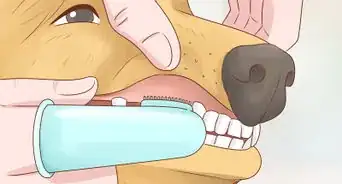
 How to Tell if Your Dog Is in Pain
How to Tell if Your Dog Is in Pain
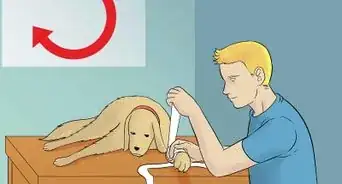



References
- ↑ https://www.petmd.com/dog/emergency/accidents-injuries/e_dg_swollen_paws
- ↑ https://vcahospitals.com/know-your-pet/pododermatitis-in-dogs
- ↑ https://www.akc.org/expert-advice/health/dog-allergies-symptoms-treatment/
- ↑ https://www.petmd.com/dog/emergency/accidents-injuries/e_dg_swollen_paws
- ↑ https://vethelpdirect.com/vetblog/2021/03/25/how-can-i-tell-if-my-dog-has-an-infection/
- ↑ https://www.ncbi.nlm.nih.gov/pmc/articles/PMC4982575/
- ↑ https://www.vet.cornell.edu/departments-centers-and-institutes/riney-canine-health-center/health-info/canine-skin-autoimmune-diseases
- ↑ https://vcahospitals.com/know-your-pet/pemphigus-in-dogs
- ↑ https://www.nhah.com/metabolic-a-endocrine
- ↑ https://www.ncbi.nlm.nih.gov/pmc/articles/PMC4982575/
- ↑ https://www.akc.org/expert-advice/health/cancer-senior-dogs-signs-symptoms-to-watch-for/
- ↑ https://www.petmd.com/dog/emergency/accidents-injuries/e_dg_swollen_paws
- ↑ https://vcahospitals.com/know-your-pet/first-aid-for-torn-or-injured-foot-pads-in-dogs
- ↑ https://www.ncbi.nlm.nih.gov/pmc/articles/PMC4982575/
- ↑ https://www.petmd.com/dog/emergency/accidents-injuries/e_dg_swollen_paws
- ↑ https://vcahospitals.com/know-your-pet/antibiotic-resistant-bacterial-infections-in-dogs
- ↑ https://www.ncbi.nlm.nih.gov/pmc/articles/PMC4982575/
- ↑ https://veterinaryemergencygroup.com/blog/dog-allergies/
- ↑ https://vcahospitals.com/know-your-pet/common-emergencies-in-dogs
- ↑ https://www.petmd.com/dog/conditions/cancer/c_dg_squamous_cell_carcinoma_digit
- ↑ https://www.akcchf.org/canine-health/your-dogs-health/caring-for-your-dog/keeping-dogs-paws-healthy.html
- ↑ https://www.akcchf.org/canine-health/your-dogs-health/caring-for-your-dog/keeping-dogs-paws-healthy.html
- ↑ https://www.akcchf.org/canine-health/your-dogs-health/caring-for-your-dog/keeping-dogs-paws-healthy.html
- ↑ https://www.rspca.org.uk/adviceandwelfare/seasonal/summer/dogs
- ↑ https://dogsbestlife.com/dog-health/weed-killers/
- ↑ https://www.akcchf.org/canine-health/your-dogs-health/caring-for-your-dog/keeping-dogs-paws-healthy.html
- ↑ https://www.ncbi.nlm.nih.gov/pmc/articles/PMC4982575/
- ↑ https://www.ncbi.nlm.nih.gov/pmc/articles/PMC4982575/
- ↑ https://www.petmd.com/dog/emergency/accidents-injuries/e_dg_swollen_paws
- ↑ https://www.akcchf.org/canine-health/your-dogs-health/caring-for-your-dog/keeping-dogs-paws-healthy.html
About This Article





